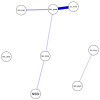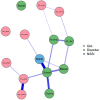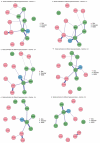The Association of Nonsuicidal Self-Injury with Quality of Life and Mental Disorders in Clinical Adolescents-A Network Approach
- PMID: 33672808
- PMCID: PMC7918829
- DOI: 10.3390/ijerph18041840
The Association of Nonsuicidal Self-Injury with Quality of Life and Mental Disorders in Clinical Adolescents-A Network Approach
Abstract
Although earlier research has highlighted that psychiatric disorders significantly impair patients' quality of life (QoL), few studies have examined the relationship between nonsuicidal self-injury (NSSI) and QoL. Our aim was to investigate whether QoL mediates the mental disorder-NSSI relationship, and to study the QoL ratings agreement of self and parents in a clinical population of adolescents. We involved 202 adolescents from Vadaskert Child Psychiatric Hospital and Outpatient Clinic, Budapest, aged 13-18 years. All participants completed the Deliberate Self-Harm Inventory, Inventar zur Erfassung der Lebensqualität bei Kindern und Jugendlichen, and the Mini International Neuropsychiatric Interview Kid. To map the interrelationship between the NSSI, mental disorders, and QoL dimensions, Mixed Graphical Models were estimated. Adolescents with a history of NSSI rated their QoL to be significantly lower than adolescents without NSSI. Self and parents' QoL ratings are closer in the NSSI sample than in the no-NSSI sample. Among all QoL dimensions, only family problems had a direct significant association with NSSI engagement. Our results highlight that, contrary to our hypothesis, the presence of mental disorders mediates the relationship between most QoL dimensions and the occurrence of NSSI. Our results draw attention to the potential causal effect of environmental factors (e.g., peer problems) on mental disorders that, in turn, result in NSSI. The present paper highlights the importance of network modelling in clinical research.
Keywords: adolescents; mental disorders; network approach; non-suicidal self-injury; parent-report; quality of life; self-report.
Conflict of interest statement
The authors declare no conflict of interest.
Figures



Similar articles
-
Attention-deficit hyperactivity disorder and nonsuicidal self-injury in a clinical sample of adolescents: the role of comorbidities and gender.BMC Psychiatry. 2018 Feb 6;18(1):34. doi: 10.1186/s12888-018-1620-3. BMC Psychiatry. 2018. PMID: 29409473 Free PMC article.
-
Examining the Course of Suicidal and Nonsuicidal Self-Injurious Thoughts and Behaviors in Outpatient and Inpatient Adolescents.J Abnorm Child Psychol. 2017 Jul;45(5):971-983. doi: 10.1007/s10802-016-0214-0. J Abnorm Child Psychol. 2017. PMID: 27761783 Free PMC article.
-
Peer Bullying and Psychiatric Diagnoses in Adolescents with Nonsuicidal Self-Injury.Psychiatry. 2024 Winter;87(4):298-313. doi: 10.1080/00332747.2024.2379752. Epub 2024 Aug 5. Psychiatry. 2024. PMID: 39102646
-
The epidemiology and phenomenology of non-suicidal self-injurious behavior among adolescents: a critical review of the literature.Arch Suicide Res. 2007;11(2):129-47. doi: 10.1080/13811110701247602. Arch Suicide Res. 2007. PMID: 17453692 Review.
-
Examining the link between nonsuicidal self-injury and suicidal behavior: a review of the literature and an integrated model.Clin Psychol Rev. 2012 Aug;32(6):482-95. doi: 10.1016/j.cpr.2012.05.003. Epub 2012 May 11. Clin Psychol Rev. 2012. PMID: 22717336 Review.
Cited by
-
The Association between Nonsuicidal Self-Injury and Perfectionism in Adolescence: The Role of Mental Disorders.Eur J Investig Health Psychol Educ. 2023 Oct 24;13(11):2299-2327. doi: 10.3390/ejihpe13110163. Eur J Investig Health Psychol Educ. 2023. PMID: 37998053 Free PMC article.
-
Health-related quality of life in children, adolescents and young adults with self-harm or suicidality: A systematic review.Aust N Z J Psychiatry. 2023 Jul;57(7):952-965. doi: 10.1177/00048674231165477. Epub 2023 Apr 10. Aust N Z J Psychiatry. 2023. PMID: 37036112 Free PMC article.
-
The importance of recognizing worthlessness for suicide prevention in adolescents with Attention-deficit/hyperactivity disorder.Front Psychiatry. 2022 Nov 15;13:969164. doi: 10.3389/fpsyt.2022.969164. eCollection 2022. Front Psychiatry. 2022. PMID: 36458127 Free PMC article.
-
Development of a General Health Score Based on 12 Objective Metabolic and Lifestyle Items: The Lifestyle and Well-Being Index.Healthcare (Basel). 2022 Jun 11;10(6):1088. doi: 10.3390/healthcare10061088. Healthcare (Basel). 2022. PMID: 35742139 Free PMC article.
-
Clinical and psychological profiles of patients with different patterns of nonsuicidal self-injury.Front Psychiatry. 2025 Jun 19;16:1570880. doi: 10.3389/fpsyt.2025.1570880. eCollection 2025. Front Psychiatry. 2025. PMID: 40612027 Free PMC article.
References
-
- American Psychiatric Association (APA) Diagnostic and Statistical Manual of Mental Disorders. 5th ed. APA; Arlington, VA, USA: 2013.
-
- Brunner R., Kaess M., Parzer P., Fischer G., Carli V., Hoven C.W., Wasserman C., Sarchiapone M., Resch F., Apter A., et al. Life-time prevalence and psychosocial correlates of adolescent direct self-injurious behavior: A comparative study of findings in 11 European countries. J. Child Psychol. Psychiatry. 2014;55:337–348. doi: 10.1111/jcpp.12166. - DOI - PubMed
Publication types
MeSH terms
LinkOut - more resources
Full Text Sources
Other Literature Sources
Medical

